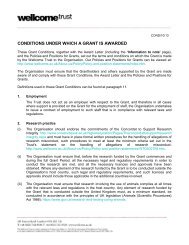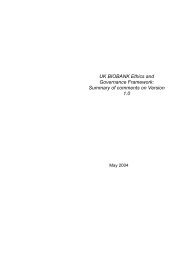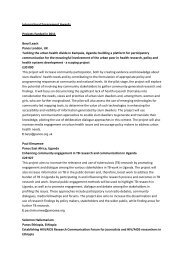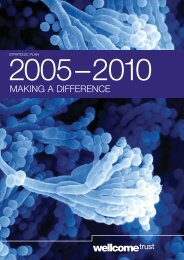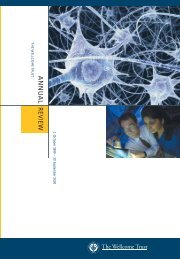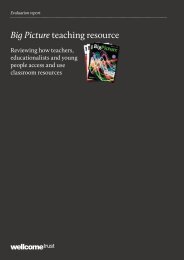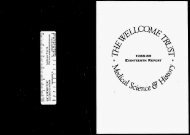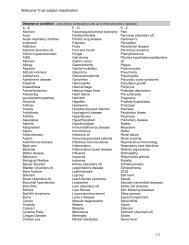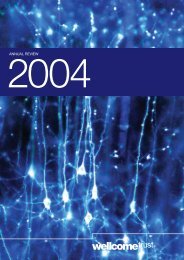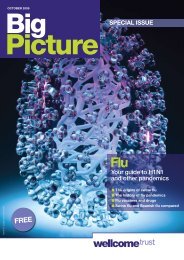refer to our guidelines - Wellcome Trust
refer to our guidelines - Wellcome Trust
refer to our guidelines - Wellcome Trust
Create successful ePaper yourself
Turn your PDF publications into a flip-book with our unique Google optimized e-Paper software.
February 2013<br />
<strong>Wellcome</strong> <strong>Trust</strong> Logo Guidelines
<strong>Wellcome</strong> <strong>Trust</strong> Logo Guidelines<br />
1 Use of <strong>our</strong> logotypes<br />
1<br />
Single endorsement<br />
logotype: Supported<br />
by, Strategic Award,<br />
Investiga<strong>to</strong>r and<br />
Fellow<br />
These f<strong>our</strong> versions of <strong>our</strong> <strong>Wellcome</strong><br />
<strong>Trust</strong> endorsement logotype (Supported<br />
by, Strategic Award, Investiga<strong>to</strong>r and<br />
Fellow) have been created <strong>to</strong> clarify the<br />
nature of <strong>our</strong> support. Please use the<br />
version relevant <strong>to</strong> y<strong>our</strong> funding status.<br />
Provided you remain in receipt of current<br />
<strong>Wellcome</strong> <strong>Trust</strong> funding, the logos can be<br />
used as required for websites, presentations,<br />
paperwork and promotional materials.<br />
The logotypes have been specially created<br />
and no attempt should be made <strong>to</strong> recreate<br />
the logotypes in any way. Please do not<br />
alter, dis<strong>to</strong>rt or adjust the letterforms,<br />
type style and visual relationships.<br />
These versions of the logotype have been<br />
created <strong>to</strong> give a balanced and practical<br />
arrangement of the visual elements,<br />
ensuring maximum legibility at all times.<br />
The <strong>Wellcome</strong> <strong>Trust</strong> logotypes are<br />
available in positive and negative.<br />
Supported by<br />
If you or y<strong>our</strong> work are directly funded only<br />
by the <strong>Wellcome</strong> <strong>Trust</strong> then you can use the<br />
‘Supported by’ logo <strong>to</strong> recognise y<strong>our</strong> status.<br />
Investiga<strong>to</strong>r<br />
If you are in receipt of a <strong>Wellcome</strong> <strong>Trust</strong> Investiga<strong>to</strong>r<br />
Award then you may p<strong>refer</strong> <strong>our</strong> ‘Investiga<strong>to</strong>r’ logo.<br />
Strategic Award<br />
If you are in receipt of a <strong>Wellcome</strong> <strong>Trust</strong> Strategic Award<br />
then you may p<strong>refer</strong> <strong>to</strong> use the ‘Strategic Award’ logo.<br />
Fellow<br />
If you are in receipt of a <strong>Wellcome</strong> <strong>Trust</strong> fellowship<br />
then you may p<strong>refer</strong> <strong>to</strong> use the ‘Fellow’ logo.
<strong>Wellcome</strong> <strong>Trust</strong> Logo Guidelines<br />
2 Use of <strong>our</strong> logotypes<br />
2<br />
Single endorsement<br />
logotypes: exclusion<br />
zone/minimum size<br />
Exclusion zone:<br />
We have created an exclusion zone in order <strong>to</strong><br />
preserve the authority and legibility of the<br />
<strong>Wellcome</strong> <strong>Trust</strong> logo, which should never<br />
appear crowded by other elements. See the<br />
diagram on the right for guidance on<br />
minimum spacing.<br />
When using the logotype the p<strong>refer</strong>red<br />
placement for printed materials is the bot<strong>to</strong>m<br />
or <strong>to</strong>p left of the format. The margins are<br />
defined by the size of the format and the logo<br />
size (see below as a simple guide).<br />
Always take care <strong>to</strong> maintain the<br />
exclusion zone.<br />
Minimum size:<br />
To maintain legibility of the <strong>Wellcome</strong> <strong>Trust</strong><br />
logo it should never appear smaller than<br />
30mm. Please consult the Brand Manager<br />
for advice on logotype and sizes.<br />
Exclusion zone<br />
Format Margin Logo size<br />
A6 5mm 30mm<br />
A5 10mm 40mm<br />
A4 12mm 50mm<br />
A3 15mm 60mm<br />
A2 20mm scale in proportion<br />
A1 28mm scale in proportion<br />
A0 40mm scale in proportion<br />
Minimum size<br />
30mm<br />
30mm 30mm 30mm
<strong>Wellcome</strong> <strong>Trust</strong> Logo Guidelines<br />
3 Use of <strong>our</strong> logotypes<br />
3<br />
Single endorsement:<br />
examples<br />
Definition of the endorsement mode:<br />
• The visual and verbal identity of the<br />
entity is clearly separate from that<br />
of the <strong>Wellcome</strong> <strong>Trust</strong>.<br />
• The entity may have defined logotype or a<br />
text name using the typeface of the entity.<br />
• The <strong>Wellcome</strong> <strong>Trust</strong> logotype should<br />
never appear within or as part of the<br />
entity’s name/logo. This can challenge<br />
the integrity of <strong>our</strong> logotype and<br />
create confusing hierarchies. The<br />
<strong>Wellcome</strong> <strong>Trust</strong> logotype is present as<br />
an endorsement mark only, separate<br />
from the main communication.<br />
• There are f<strong>our</strong> <strong>Wellcome</strong> <strong>Trust</strong><br />
endorsement types: ‘Supported by’,<br />
‘Strategic Award’ and ‘Investiga<strong>to</strong>r’ and<br />
‘Fellow’. The name of the entity may or<br />
may not contain the words <strong>Wellcome</strong><br />
<strong>Trust</strong>. In order <strong>to</strong> help build clear<br />
understanding as <strong>to</strong> the nature of <strong>our</strong><br />
organisation as a charitable foundation it<br />
is p<strong>refer</strong>able <strong>to</strong> use <strong>Wellcome</strong> <strong>Trust</strong> rather<br />
than Henry <strong>Wellcome</strong> or <strong>Wellcome</strong> alone.<br />
THE CENTRE<br />
OF THE CELL<br />
Supporter/funder:<br />
The Centre of the Cell<br />
A ‘Supported by’ version of <strong>our</strong> logotype<br />
exists for use when the <strong>Trust</strong> wishes <strong>to</strong> signify<br />
a contribution <strong>to</strong> an entity without implying<br />
a controlling influence. This version of the<br />
logotype should be applied as shown here.<br />
Oxford Centre<br />
for Neuroethics<br />
Supporter/funder, <strong>Wellcome</strong> <strong>Trust</strong> Strategic<br />
Award: Oxford Centre for Neuroethics<br />
Certain funded institutions are the<br />
recipients of a <strong>Wellcome</strong> <strong>Trust</strong> Strategic<br />
Award. For these entities, an identifier<br />
line is included in communications. This<br />
can be used either as a separate graphic<br />
element or, when space is limited, locked<br />
underneath <strong>our</strong> logotype as shown here.<br />
A ‘Supported by’ logotype should not<br />
be used for Strategic Awards.
<strong>Wellcome</strong> <strong>Trust</strong> Logo Guidelines<br />
4 Visual identity<br />
4<br />
Multiple<br />
endorsement<br />
logotype<br />
Please use the main <strong>Wellcome</strong> <strong>Trust</strong> logo<br />
if you are funded by the <strong>Wellcome</strong> <strong>Trust</strong><br />
and at least one other organisation.<br />
Provided you remain in receipt of current<br />
<strong>Wellcome</strong> <strong>Trust</strong> funding, the logos can be<br />
used as required for websites, presentations,<br />
paperwork and promotional materials.<br />
The logotypes have been specially created<br />
and no attempt should be made <strong>to</strong> recreate<br />
the logotypes in any way. Please do not<br />
alter, dis<strong>to</strong>rt or adjust the letterforms,<br />
type style and visual relationships.<br />
These versions of the logotype have been<br />
created <strong>to</strong> give a balanced and practical<br />
arrangement of the visual elements,<br />
ensuring maximum legibility at all times.<br />
The <strong>Wellcome</strong> <strong>Trust</strong> logotypes are<br />
available in positive and negative.<br />
<strong>Wellcome</strong> <strong>Trust</strong> logotype (positive)<br />
Main logo<br />
If y<strong>our</strong> work is directly funded by the<br />
<strong>Wellcome</strong> <strong>Trust</strong> and at least one other<br />
organisation, then you can use the main<br />
<strong>Wellcome</strong> <strong>Trust</strong> logo <strong>to</strong> recognise y<strong>our</strong> status.<br />
<strong>Wellcome</strong> <strong>Trust</strong> logotype (negative)
<strong>Wellcome</strong> <strong>Trust</strong> Logo Guidelines<br />
5 Use of <strong>our</strong> logotypes<br />
5<br />
Multiple<br />
endorsement<br />
logotype:<br />
exclusion zone/<br />
minimum size<br />
Exclusion zone:<br />
We have created an exclusion zone in order <strong>to</strong><br />
preserve the authority and legibility of the<br />
<strong>Wellcome</strong> <strong>Trust</strong> logo, which should never<br />
appear crowded by other elements. See the<br />
diagram on the right for guidance on<br />
minimum spacing.<br />
When using the logotype the p<strong>refer</strong>red<br />
placement for printed materials is the bot<strong>to</strong>m<br />
or <strong>to</strong>p left of the format. The margins are<br />
defined by the size of the format and the logo<br />
size (see below as a simple guide).<br />
Always take care <strong>to</strong> maintain the<br />
exclusion zone.<br />
Minimum size:<br />
To maintain legibility of the <strong>Wellcome</strong> <strong>Trust</strong><br />
logo it should never appear smaller than<br />
30mm. Please consult the Brand Manager<br />
for advice on logotype and sizes.<br />
Exclusion zone<br />
Minimum size 30mm<br />
Format Margin Logo size<br />
A6 5mm 30mm<br />
A5 10mm 40mm<br />
A4 12mm 50mm<br />
A3 15mm 60mm<br />
A2 20mm scale in proportion<br />
A1 28mm scale in proportion<br />
A0 40mm scale in proportion
<strong>Wellcome</strong> <strong>Trust</strong> Logo Guidelines<br />
6 Use of <strong>our</strong> logotypes<br />
6<br />
Multiple<br />
endorsement<br />
logotype: examples<br />
SUBMISSION OF EVIDENCE<br />
Leveson inquiry: Culture, practice and ethics of the press<br />
Response by the Association of Medical Research Charities, Cancer Research<br />
UK and the <strong>Wellcome</strong> <strong>Trust</strong><br />
January 2012<br />
Key Points<br />
1. Science s<strong>to</strong>ries form an important part of many newspapers. While the standard of<br />
science reporting has improved considerably over the past ten years, there are still<br />
instances of inaccuracy, misrepresentation and misinterpretation which can be damaging<br />
for both patients and the public. We make the following recommendations <strong>to</strong> address<br />
these concerns:<br />
a. News edi<strong>to</strong>rs should be enc<strong>our</strong>aged <strong>to</strong> seek advice from specialist<br />
correspondents <strong>to</strong> ensure that science s<strong>to</strong>ries are accurately and responsibly<br />
reported.<br />
Definition of the endorsement mode:<br />
b. The Press Complaints Commission guidance should be strengthened <strong>to</strong> allow<br />
any interested party <strong>to</strong> complain about inaccurate reporting.<br />
c. Corrections and clarifications should be given equivalent prominence <strong>to</strong> the<br />
original article when complaints are upheld.<br />
d. Links <strong>to</strong> additional s<strong>our</strong>ces of information should be included in online articles<br />
wherever possible.<br />
• The visual and verbal identity of the<br />
entity is clearly separate from that<br />
of the <strong>Wellcome</strong> <strong>Trust</strong>.<br />
• The entity may have defined logotype or a<br />
text name using the typeface of the entity.<br />
• The <strong>Wellcome</strong> <strong>Trust</strong> logotype should<br />
never appear within or as part of the<br />
entity’s name/logo. This can challenge<br />
the integrity of <strong>our</strong> logotype and create<br />
confusing hierarchies. The <strong>Wellcome</strong><br />
<strong>Trust</strong> logotype is present but separate<br />
from the main communication.<br />
• The name of the entity may or may not<br />
contain the words <strong>Wellcome</strong> <strong>Trust</strong>. In<br />
order <strong>to</strong> help build clear understanding<br />
as <strong>to</strong> the nature of <strong>our</strong> organisation as<br />
a charitable foundation it is p<strong>refer</strong>able<br />
<strong>to</strong> use <strong>Wellcome</strong> <strong>Trust</strong> rather than<br />
Henry <strong>Wellcome</strong> or <strong>Wellcome</strong> alone.<br />
• Partnership layouts also apply <strong>to</strong> internal<br />
documents for example submission<br />
of evidences or meeting agendas.<br />
Partners: MRC, UCL, Imperial<br />
College London, King's College<br />
London and Cancer Research UK.<br />
Support for the future leaders<br />
of biomedical research<br />
Partner: The Royal Society.<br />
January 2012<br />
INTRODUCTION<br />
2. Newspapers remain one of the chief s<strong>our</strong>ces through which the public obtains<br />
information about science. The 2011 Public Attitudes <strong>to</strong> Science report, commissioned<br />
from Ipsos-MORI by the Government Office for Science, found that a third of people hear<br />
or read about science most often from print newspapers. 1 It therefore matters how<br />
science is reported in the press.<br />
1 “People hear or read about science most often through traditional media, such as television (54%) and print<br />
newspapers (32%). A fifth (19%) say one of their two most regular s<strong>our</strong>ces of information is the internet,<br />
though very few (2%) use science blogs specifically as one of their most regular s<strong>our</strong>ces.” http://www.ipsosmori.com/Assets/Docs/Polls/sri-pas-2011-main-report.pdf,<br />
page 3<br />
Partners: Cancer Research UK<br />
and AMRC.<br />
1
<strong>Wellcome</strong> <strong>Trust</strong> Logo Guidelines<br />
8 | Back | Contents | Next<br />
Contact<br />
For further information or advice on using<br />
the <strong>Wellcome</strong> <strong>Trust</strong> brand, please contact:<br />
Sam Hill<br />
Brand Manager<br />
E s.hill@wellcome.ac.uk<br />
T +44 (0)20 7611 7264<br />
Logo requests:<br />
www.wellcome.ac.uk/Logo-usage



